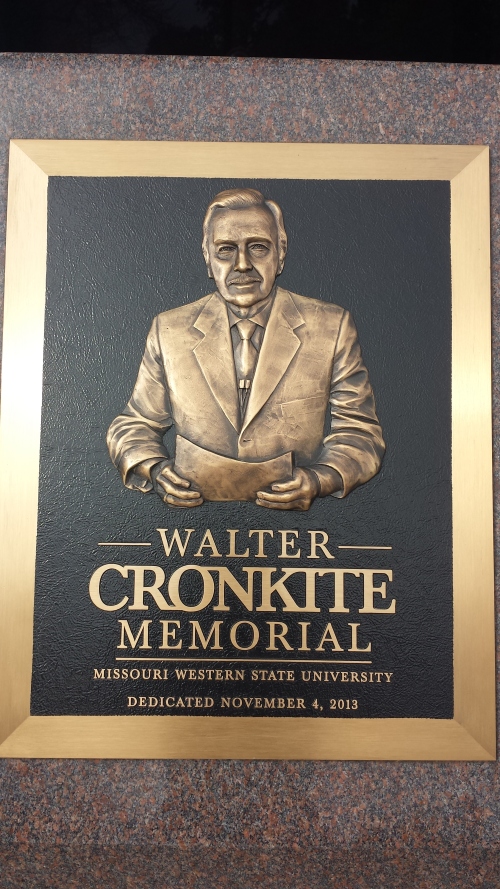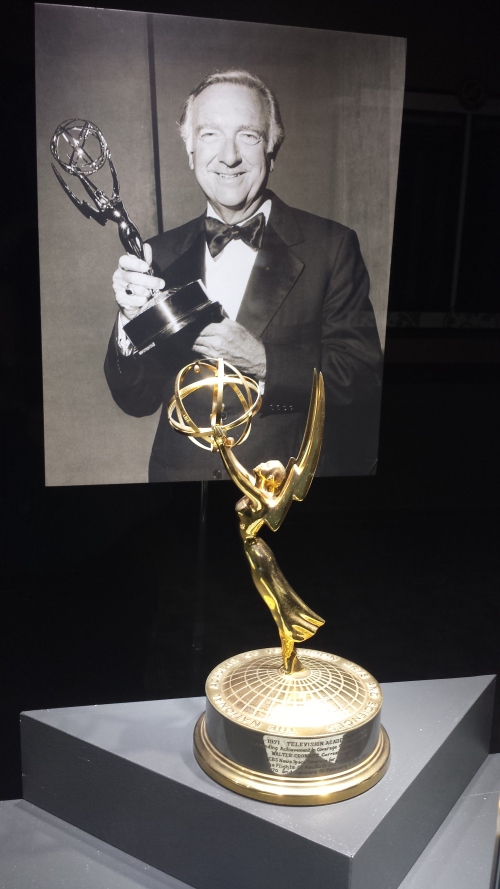By coincidence, my travel schedule this month took me on consecutive weekends to two universities with exhibits honoring Walter Cronkite.
My family did not have a television when Cronkite made his debut as CBS anchor in 1962. One of the biggest stories of his career — the 1963 assassination of President John F. Kennedy — finally made Mom and Dad cave and buy our first “idiot box” (Mom called it that before we got one and through the years as she became a loyal watcher). So of course, we missed Cronkite’s announcement of Kennedy’s death:
The Cronkite exhibits at Missouri Western State University and the Walter Cronkite School of Journalism and Mass Communication at Arizona State University both take note of the importance of the Kennedy coverage in the anchor’s career:

A Kennedy display at the Walter Cronkite Memorial in St. Joseph, Mo., includes a period TV set, playing video of Cronkite’s coverage of the Kennedy assassination and funeral, with newspapers and photos relating to assassination coverage.

The Cronkite Gallery at Arizona State features a collection of newspapers covering the Kennedy assassination, with a photo of Cronkite removing his glasses to read the news of JFK’s death.
The two universities have different connections to the famed journalist, who actually attended the University of Texas, but left after two years and didn’t graduate. MWSU is in St. Joseph, Mo., Cronkite’s birthplace. President Robert Vartabedian is a Cronkite buff who led efforts to build the Walter Cronkite Memorial, dedicated last year.
On Monday, Nov. 3, I was a panelist for the Cronkite Conference on Media Ethics & Integrity, part of the university’s efforts to honor St. Joe’s native son.
ASU’s school of journalism was named for Cronkite in 1984 (after a friend asked Cronkite to help the program). ASU’s memorial to the giant of broadcast journalism is primarily its growth into one of the nation’s leading journalism schools. But on the second floor of its building in downtown Phoenix, a Cronkite Gallery presents a mix of journalism artifacts unrelated to Cronkite with some exhibits focusing on him. I had missed the gallery on earlier visits to Arizona State’s downtown Phoenix campus. I’d visited various offices, classrooms and conference rooms, but not the collection of journalism memorabilia.
The Cronkite Memorial in St. Joe would be harder to miss. As you approach Spratt Hall, large banners identify it as the home of the Cronkite Memorial. As you step inside the building’s door, a display of TV screens on the atrium wall leaves no doubt.
The atrium is a mini-museum about the broadcaster’s career. One wall is a timeline:
Murals about Cronkite’s role in covering space travel cover the opposite walls between the first and second floors.
Each collection also includes an exhibit focused on space exploration and Cronkite’s enthusiasm for it.

Cronkite holds up a front page in this photo in the Cronkite Gallery, surrounded by more front pages about space exploration.

In the days before computer simulations, Cronkite used models to show what was happening in space, as in this photo in the space exhibit at the Cronkite Memorial.
Special displays honor Cronkite’s work covering wars, first as a war correspondent in World War II.

A display on Cronkite’s coverage of Vietnam plays his famous broadcast commentary when he told the nation he was convinced we could not win the war.
Cronkite won enough Emmys for each of the exhibits to display one:
A fun aspect of the Cronkite Memorial is the collection of caricatures by Al Hirschfeld, a friend of Cronkite’s.
Cronkite was one of the biggest figures of journalism in my lifetime. Certainly none of the TV news stars since has achieved his stature, as big as Tom Brokaw, Peter Jennings, Dan Rather and Barbara Walters were on the traditional networks. The cable networks haven’t produce a star approaching Cronkite’s importance.
As a longtime print journalist, I’d like to argue that Ben Bradlee, Bob Woodward, Carl Bernstein, Abe Rosenthal, Ellen Goodman, Leonard Pitts, Seymour Hersh, Neil Sheehan, Edna Buchanan, Richard Ben Cramer, Mike Royko, Carol Guzy, Nick Ut, Jim Risser or someone was bigger than Cronkite. And maybe some or all of them, and more, were better journalists. But bigger? I don’t think I could make that case.
I was always a little annoyed with his signature line, “That’s the way it is.” It always came across to me as pompous. If I had ever heard him confess that it was an aspiration, not a boast, I might have liked it. But the truth is that we do our best, but even when we tell our stories accurately, the world we cover is too complex suggest that a half-hour newscast (minus commercial time) tells “the way it is.” Every single day of his career, even on “slow” news days, Cronkite knew of significant news that didn’t make the newscast. Just like the inaccurate boast that the New York Times is “All the News That’s Fit to Print,” Cronkite’s line said more about arrogance than it did about the news report.
But I look past the Times’ slogan and recognize it as the pinnacle of American journalism. And I can look past his pompous sign-off and recognize Walter Cronkite as the giant of American journalism that he is. Especially after wandering through these two exhibits that remind me of the momentous history he covered and watch and hear his authoritative reports about those historic events.
I’m glad these universities are honoring his work and his contributions to journalism.















I am glad to see his legacy being shared. Thanks for taking us there with you. I must add that I think you are being a little picky about the slogan “and that’s the way it is” or maybe just too literal? I don’t think Walter Cronkite would ever suggest that he told us in 20 minutes everything we needed to know. He would possibly say that he hit the important points, as he saw it, and that’s the “way it is” at that time. I think he always respected the intelligence of American viewers and trusted us to seek out what wasn’t covered. Anyway Walter Cronkite is a hero of mine, so thanks again for sharing.
LikeLike
I felt so sad that I wasn’t able to go to his memorial museum in celebration of his birthday. Some day I hope to go and meet the professor who made it all happen. What a special place for all to go and experience a huge part of history and to be able to use much of it towards the way we live our lives today and in the feature. One of my favorite quotes from Walter is “In order to find out the truth then you need to hear both sides of the story.” He sure did say a mouthful there. RIP Walter L. Cronkite and my beloved brother Ronald D. Cronkite. Both gone from me in 2009. Love you both.
Corinne Cronkite
LikeLike
I hope you get a chance to visit, Corinne. It’s a special place, and you’d be really proud.
LikeLike
[…] saluted a couple giants of journalism who died this year: Ben Bradlee and John Seigenthaler. I also saluted Walter Cronkite, who died in 2009, but I visited the Cronkite Memorial in St. Joseph, Mo., as well as the Cronkite […]
LikeLike
[…] A commentary by our editor, Jim Gannon, noted how the remarkable deal came together, first raised in a live TV interview of Ford by Walter Cronkite. […]
LikeLike
[…] A commentary by our editor, Jim Gannon, noted how the remarkable deal came together, first raised in a live TV interview of Ford by Walter Cronkite. […]
LikeLike